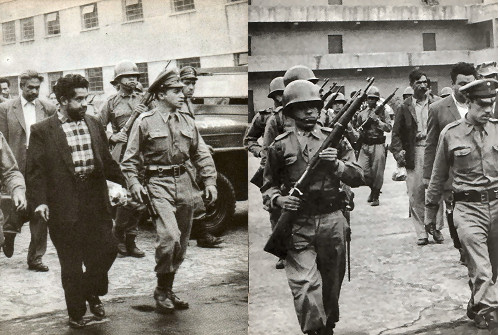
Adolfo López Mateos

The “Mexican JFK”: young, charismatic, exciting, wins 90% of vote as PRI candidate.
| Here he is with JFK, 1962. |  |
with Lyndon Johnson at UCLA, 1964. |  |
Calls himself "left," but "within the Constitution":
a liberal, but not too liberal.
Less liberal things:
--The pro-growth, anti-worker policies of the 40s and 50s make workers unhappy. When 100,000 railroad workers strike, 1959, after initial government attempts to settle the strike fail, the military raids their union hall, accusing the union's leaders of being Communist puppets, and arrest union leader Demetrio Vallejo (seen below). Vallejo is sentenced to 16 years in prison for the crime of "social dissolution." Section 145 of the penal code bans "any foreigner or Mexican national who in speech or writing or by any other means...disturb[s] the public order or affect[s] the sovereingty of the Mexican state," which pretty much means whatever the President wants it to mean.

--When muralist David Siqueiros criticizes the government's repression of strikers, he too is charged with social dissolution and imprisoned for 4 years, during which he paints his cell walls and then does 250 self-portraits.
--Many are suspicious of Interior Minister Gustavo Díaz Ordaz, the president-in-waiting (López Mateos formally names him as his successor in November 1963), who applies the social-dissolution laws quite vigorously. He is a reactionary who "should not and can not become president," says the magazine Politica. Unfortunately, he does.

Liberal things:
--after breaking the railroad union, the President puts more funding into the social security system and stretches it to cover many more workers (# people covered increases 250%, 1958-65)
--redistributes 30 million acres of land, builds clinics in remote rural areas and wipes out cholera through vaccination; also greatly lessens malaria, polio, TB
--Mexico is 51% urban in 1960 (had been 29% urban in 1910; US had reached 51% urban in 1920); problems remain: illiteracy rate cut in half, 1910-60, from 80%-40%, but population explosion means there are actually more illiterates than in 1910. To remedy this, the President gives villages building materials and plans, allowing them to build schools themselves. He then has millions of standard textbooks for grades K-5 printed and gives them to every school free. The textbooks teach the PRI version of history, focusing on the church's war against Benito Juárez, its treachery in inviting Maximilian into the country, and the Cristero Revolt. Even religious schools must use them. Their covers feature Victoria Dorenlas, a probably folkloric figure who incarnates Mexico's pluricultural population.
--after the Bay of Pigs invasion in 1961, in which the US attempts to overthrow Fidel Castro, the rest of the nations in the hemisphere break relations with Cuba. López Mateos does not, arguing that every country in the region should undergo a nationalist revolution like Mexico's in 1910 in order to obtain "national respect and sovereignty," which Cuba may well be doing. Mexico does not carry on significant trade with Cuba; it merely respects Cuba's right to choose its own path. In return, Cuba does not support revolutionary movements inside Mexico.
Ambiguous things:
--The PRI had controlled at least 90% of the seats in the lower house of congress, 1946-61. The reformist Political Law of 1962 enables other parties to challenge them, sort of. Minority parties will now win representation based on the percentage of votes they won in elections: you're guaranteed 5 seats if you win 2.5% of the total vote, even if you didn't win anywhere. The PAN becomes the main opposition party, but historians note that it's not much of an opposition. (Founded in 1939, it does not win a significant electoral contest until gaining a state governorship in 1989 [before then, every single governor of every single state in every single election was from the PRI] and then wins the presidency in 2000 and 2006.) This system "masks the PRI's monopoly of political power": between 1964-76, the PRI wins more than 80% of votes in federal elections. It wins 153 of 162 congressional seats in the 1958 elections, 175 of 210 in 1964. "This modification should not be understood as a gradual evolution of the Mexican political system towards either a multi-party system or participatory democracy," one historian remarks.
Some old revolutionaries find this troubling. In 1961, inspired by the Cuban Revolution, Lázaro Cárdenas gathers the Mexican left into the MLN (National Liberation Movement), aiming to "contribute to the fulfillment of the principles of the Mexican Revolution." This is a problem for the PRI in several ways: their most famous and inspiring leader is suggesting that something outside the PRI can help the people; he's suggesting that the PRI isn't dealing with the people's needs as a "revolutionary" party should; he's looking outside of Mexico for inspiration.
This "civic organization" is a forerunner of the civil-society organizations that arise in the 1980s after the earthquake. It advocates expansion of agrarian reform, fairer distribution of wealth, control over natural resources and an independent foreign policy, within a reformist framework (that is, they don't want to overthrow the country). The US sees it as a Communist front and pushes the Mexican government to suppress the movement.
The party eventually splits over whether or not to run in elections as a real opposition party, which Cárdenas opposes, still feeling some loyalty to the PRI ("the organization of new political parties belongs to the generations that follow us"). It is finally crushed in 1968, when many of its remaining leaders are arrested as part of the crushing of the student movement.
--Due to low taxes to help businesses grow in the 1940s and 50s, income distribution is hugely unfair: the bottom 60% of the population, mainly peasants and indigenous groups, earns about 22% of income; the middle 30%, factory workers and the middle class, earn 37%, and the top 10% earns 42% of the national income.